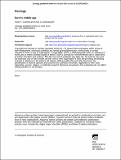Files in this item
Earth's middle age
Item metadata
| dc.contributor.author | Cawood, Peter Anthony | |
| dc.contributor.author | Hawkesworth, Chris | |
| dc.date.accessioned | 2014-04-14T11:01:01Z | |
| dc.date.available | 2014-04-14T11:01:01Z | |
| dc.date.issued | 2014-06-01 | |
| dc.identifier | 110579489 | |
| dc.identifier | 094169d2-43cc-4692-a15a-496e78adae9c | |
| dc.identifier | 84902122156 | |
| dc.identifier | 000339961100013 | |
| dc.identifier.citation | Cawood , P A & Hawkesworth , C 2014 , ' Earth's middle age ' , Geology , vol. 42 , no. 6 , pp. 503-506 . https://doi.org/10.1130/G35402.1 | en |
| dc.identifier.issn | 0091-7613 | |
| dc.identifier.uri | https://hdl.handle.net/10023/4569 | |
| dc.description | This research was funded through Natural Environment Research Council (grant NE/J021822/1) and the APC was paid through the RCUK OA block grant. | en |
| dc.description.abstract | Earth's middle age, extending from 1.7 to 0.75 Ga, was characterized by environmental, evolutionary, and lithospheric stability that contrasts with the dramatic changes in preceding and succeeding eras. The period is marked by a paucity of preserved passive margins, an absence of a significant Sr anomaly in the paleoseawater record and in the εHf(t) in detrital zircon, a lack of orogenic gold and volcanic-hosted massive sulfide deposits, and an absence of glacial deposits and iron formations. In contrast, anorthosites and kindred bodies are well developed and major pulses of Mo and Cu mineralization, including the world's largest examples of these deposits, are features of this period. These trends are attributed to a relatively stable continental assemblage that was initiated during assembly of the Nuna supercontinent by ca. 1.7 Ga and continued until breakup of its closely related successor, Rodinia, ca. 0.75 Ga. The overall low abundance of passive margins is consistent with a stable continental configuration, which also provided a framework for environmental and evolutionary stability. A series of convergent margin accretionary orogens developed along the edge of the supercontinent. Abundant anorthosites and related rocks developed inboard of the plate margin. Their temporal distribution appears to link with the secular cooling of the mantle, at which time the overlying continental lithosphere was strong enough to be thickened and to support the emplacement of large plutons into the crust, yet the underlying mantle was still warm enough to result in widespread melting of the lower thickened crust. | |
| dc.format.extent | 4 | |
| dc.format.extent | 242989 | |
| dc.language.iso | eng | |
| dc.relation.ispartof | Geology | en |
| dc.subject | Anorthosites | en |
| dc.subject | Nuna supercontinent | en |
| dc.subject | Rodinia | en |
| dc.subject | Stable continental configuration | en |
| dc.subject | Accretionary orogens | en |
| dc.subject | Geological stability | en |
| dc.subject | Continental lithosphere | en |
| dc.subject | Passive margins | en |
| dc.subject | QE Geology | en |
| dc.subject | BDC | en |
| dc.subject.lcc | QE | en |
| dc.title | Earth's middle age | en |
| dc.type | Journal article | en |
| dc.contributor.sponsor | NERC | en |
| dc.contributor.institution | University of St Andrews. School of Earth & Environmental Sciences | en |
| dc.contributor.institution | University of St Andrews. Scottish Oceans Institute | en |
| dc.contributor.institution | University of St Andrews. Earth and Environmental Sciences | en |
| dc.contributor.institution | University of St Andrews. St Andrews Isotope Geochemistry | en |
| dc.contributor.institution | University of St Andrews. Office of the Principal | en |
| dc.identifier.doi | https://doi.org/10.1130/G35402.1 | |
| dc.description.status | Peer reviewed | en |
| dc.identifier.grantnumber | NE/J021822/1 | en |
This item appears in the following Collection(s)
Items in the St Andrews Research Repository are protected by copyright, with all rights reserved, unless otherwise indicated.

